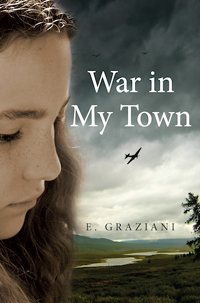| ________________
CM . . .
. Volume XXI Number 41. . . .June 26, 2015

 |
War in My Town.
E. Graziani.
Toronto, ON: Second Story Press, 2015.
184 pp., trade pbk. & epub, $11.95 (pbk.).
ISBN 978-1-927583-71-5 (pbk.), ISBN 978-1-927583-72-2 (epub).
Subject Heading:
World War, 1939-1945-Italy-Juvenile fiction.
Grades 7-11 / Ages 12-16.
Review by Ruth Latta.
*** /4
|
| |
|

excerpt:
"You again? There!" Tap, tap, tap went the rifle barrel on my head. "There!" he bellowed in broken Italian. I shut my eyes and winced at the sharp pain of the cold metal making contact with my skull. I heard my mother cry out from the distance. Others around me gasped.
The commander, amused, walked over to observe the scene. He nodded to the interpreter to attend and he was there in a flash. The commander smiled slightly as he gave instructions in German. The interpreter turned to me and said calmly, "He does not want you to be afraid. He only wants you to peel potatoes.
The commander nodded for me to go. Mery took hold of my arm. "Just do what I do," Mery whispered. "Follow me, Bruna."
In her preface, author E. Graziani says that she is "retelling [her] mother's memories. She adds: "None of the people I have written about are fictitious. They are 100% real." War in My Town recounts Bruna Pucci's World War II experiences which began on June 10, 1940 when she was 11, and when Italian head of state Benito Mussolini brought Italy into the Second World War on the side of Nazi Germany. The Pucci family, headed by a single mother, were living in poverty like the rest of their neighbours in their village, Eglio, in Tuscany, but, once the war started, their situation worsened. Food shortages became increasingly serious. Young men of the village, needed for work in agriculture, were conscripted into the military and marched away.
Worse was to come. As the Italian forces collapsed, following the Allied invasion of Italy, the Germans invaded the north. Eglio was occupied, and the villagers were forced to serve the Nazi soldiers. In September 1944, Bruna and her family were caught in a war zone between the Nazis and American liberators and saw neighbours killed in the shelling and homes and businesses reduced to rubble.
Many books have been written about the Nazi occupation of other parts of Europe, but fewer exist about Italian experiences, and Graziani deserves praise for presenting this part of the war to young readers. Classified as "juvenile fiction" by the National Library, War in My Town sounds like a memoir. Graziani has taken on the persona of her mother and has written about Bruna's experiences using the first person and the techniques of fiction such as dialogue use and dramatization.
Unlike most novels, War in My Town has six sections of historical background, beginning with "Part I: Before the War," which recounts the rise of fascism and Naziism in the 1930s, to Part 6: "Nazi Defeat and Liberation, 1945." This historical information is well worthwhile to help readers understand wartime developments, but these passages also break the flow of the story. Graziani also includes a chapter, "A Little Background," recounting, but not dramatizing, some of Bruna's family history prior to her birth in 1929.
As a novelist currently shaping a true story into fiction, I was interested in Graziani's decision to novelize most of this life-based story yet to include within the text these nonfiction, historical segments. I prefer the sort of historical novel where the necessary historical information is blended into the story or confined to a foreword or preface, but I respect Graziani's narrative choices.
The central character of War in My Town is Bruna through whose heart and mind the story is presented, but the heroine is Mama, Mathilde Pucci, whose "dignity and quiet grace" held the family together. One couldn't agree more when Bruna says of her mother (author Graziani's grandmother), "I was so proud of her and admired her to the deepest measure... because she was a woman of great courage and resolve." Yet this kind of summing up is unnecessary as Mama's actions speak for themselves.
The novel becomes particularly compelling and dramatic around page 106 when the Nazis invade Eglio, and concludes with an unexpected and satisfying reunion scene. The map and photos of the town and of Bruna and her family enrich the story. Readers who note the affection between Bruna and a village boy, Edo, will be pleased to learn in the “Author's Note” that they got married after the war and eventually moved to Canada where their second child, the author, was born.
Congratulations to E. Graziani for realizing that her mother's stories are of interest beyond the family circle and presenting them in book form for young readers.
Recommended.
Ruth Latta is an Ottawa, ON, based author. For information on Ruth Latta's books, visit http://ruthlattabooks.blogspot.com.

To comment
on this title or this review, send mail to cm@umanitoba.ca.
Copyright © the Manitoba Library Association. Reproduction for personal
use is permitted only if this copyright notice is maintained. Any
other reproduction is prohibited without permission.
Next Review | Table of Contents For This Issue - June 26, 2015
CM Home | Back Issues
| Search
| CM Archive
| Profiles Archive
|
